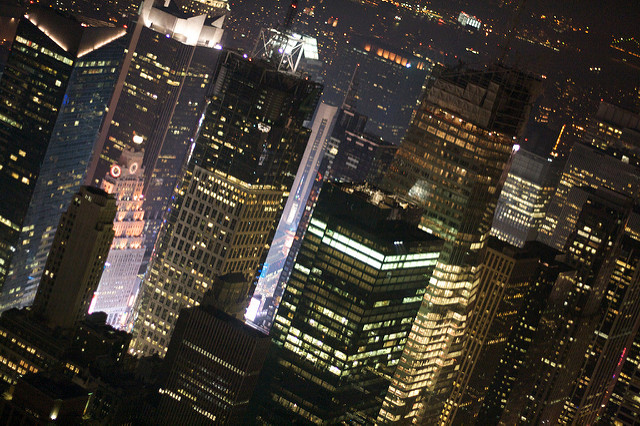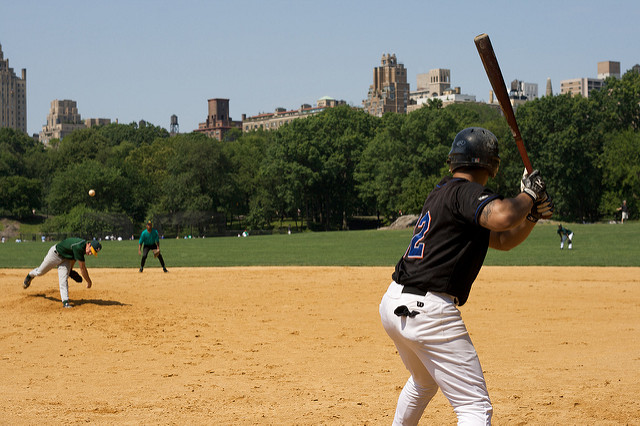
If it weren't for the American flags painted on the side of all the trains it would be easy to forget you were not in a third world country when riding the New York subway. Walk down the (normally) two flights of stairs (escalators are a rarity) and you'll find a grimy underground station, often lit by bare light bulbs dangling from the ceiling. It's immensely hot and humid in the summer and if you thought there might be a screen telling you when the next train is due you'd be sorely disappointed; you simply have to stand and wait. And indeed hope you're on the right platform since the signage probably only makes sense to the person who wrote it. Even getting on the right train is no guarantee you’ll reach your intended destination; on one occasion the train I was on suddenly turned into an express train one stop before my station, causing it to sail past the next 5 stops, after which half the carriage got out and grumpily moved to the other platform to catch another train back again.

Contrast this then with the Bay Area Rapid Transport system, or BART as it is known, some two and a half thousand miles away on the opposite side of the States. The San Francisco area transport is modern and comfortable. Displays on the platforms keep you informed of when the next train is about to arrive and when you get to the city centre, you can switch onto a tram without leaving the station to take you to any of the outer-lying districts. I was staying in San Francisco with a college friend, and we took the tram out to Ocean Beach on the shores of the Pacific Ocean. The weather downtown had been gloriously sunny, with a blue sky smiling down on a warm summer's day. Two miles away on the coast however, a dense mist reduced visibility to only a couple of hundred metres and the temperature dropped about 5 to 10 degrees. The water was freezing and I didn't venture out for a swim, but it was interesting that so close to the bustling centre it was strangely calm and almost deserted.
The weather in Texas on the other hand seemed permanently stuck on ‘slightly too warm’, veering towards the plain ‘hot’. This isn't a problem however, since the only time a lot of Texans leave their air-conditioned car is to enter an air-conditioned building. The outer road system of San Antonio makes the Spaghetti Junction look like a small country crossroads and in a land of drive-thru ATMs, drive-thru Starbucks, indeed drive-thru everything, it probably shouldn't have surprised me that at one point to get from our motel to the restaurant on the other side of the road we actually had to get in our car and drive as there was no safe way to cross.
But Texas itself is a land of contrast and only 90 miles north west of this urban jungle of never-ending industrial eyesores is the Lost Maples State Park. Walking through the forest we paused for five minutes during the ascent to a hill top, sat down and simply listened. Silence, of a sort that cannot be found even in padded city rooms, descended upon us, tranquil and calm.
The ‘Stout Irish Rock’, as the group calling themselves The Blaggards proudly claimed their genre to be, was probably the opposite of this, blaring out from a street-side bar in the Texas capital at one in the morning. Austin is known for its live music scene and so we felt we should wander the famous 6th street, although the variety in genres was disappointingly small. A slightly more unusual but increasingly popular attraction in Austin is the site of one and a half million bats setting off into the sunset in search of a nibble on the local insect population. They all nest under Congress Bridge and as the sun falls a black cloud of Mexican Free-tail bats streams out from under the bridge, over the trees on the far bank and into the night.

Since it shares the heat of the rest of Texas, Austinites (if that is the word) have as much need to cool off, but unlike the rest of Texas they have a very pleasant alternative to stale air-conditioned air. Zilker Park, just a stone's throw away from the city centre, is home to the natural Barton Springs, from whence water emerges year round at a very pleasant 21 degrees centigrade. Hollowing out some of the rock, cementing in the cracks and damming up the end has formed an absolutely enormous swimming pool, probably 200 metres long and about 25 metres wide. Admittedly at the very far end it is a mere 6 inches deep, but for the most part it has a depth of at least 2 metres and is glorious to swim in; since the water is fresh and constantly renewed there is no need for it to be chlorinated. Despite being immensely popular, the place is large enough not to feel overcrowded and many people come to just sit on the grass banks at the pool side; the naturally cool water seems to bring the temperature of the surrounding area down, making it very cool and pleasant.

The Yankees of course have Central Park, which is a wonderful oasis in the middle of the city centre, but outside of it there is very little greenery in Manhattan; in fact all I spotted was a rather strange little copse of trees growing on the side of a skyscraper, which obviously poses a question: can tree root break through re-enforced glass?!
Philadelphia on the other hand is much greener, with tree-lined streets and a few wide almost Parisian-like boulevards making it the most pleasant city I came across in the States. It is also of course the birth place of the USA, where the declaration of independence was hammered out and announced on the 4th July, 1776. How ironic then that this most American of cities feels the most European. But then, America is indeed a land of contradictions and contrast.